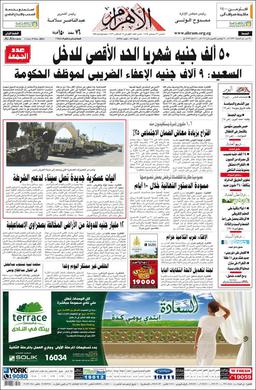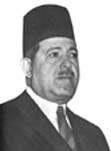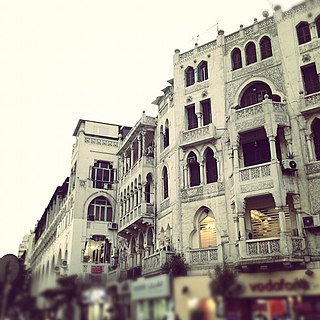
Cleopatra's Needles are a separated pair of ancient Egyptian obelisks now in London and New York City. The obelisks were originally made in Heliopolis during the New Kingdom period, inscribed by the 18th dynasty pharaoh Thutmose III and 19th dynasty pharaoh Ramesses II. In 13/12 BCE they were moved to the Caesareum of Alexandria by the prefect of Egypt Publius Rubrius Barbarus. Since at least the 17th century the obelisks have usually been named in the West after the Ptolemaic Queen Cleopatra VII. They stood in Alexandria for almost two millennia until they were re-erected in London and New York City in 1878 and 1881 respectively. Together with Pompey's Pillar, they were described in the 1840s in David Roberts' Egypt and Nubia as "[the] most striking monuments of ancient Alexandria".

Al-Ahram, founded on 5 August 1876, is the most widely circulating Egyptian daily newspaper, and the second oldest after Al-Waqa'i' al-Misriyya. It is majority owned by the Egyptian government, and is considered a newspaper of record for Egypt.

Mahmoud Fahmy El Nokrashy Pasha was an Egyptian political figure. He was the twenty-seventh prime minister of the Kingdom of Egypt.

Wādī Ḥalfā is a city in the Northern state of Sudan on the shores of Lake Nubia near the border with Egypt. It is the terminus of a rail line from Khartoum and the point where goods are transferred from rail to ferries going down the lake. As of 2007, the city had a population of 15,725. The city is located amidst numerous ancient Nubian antiquities and was the focus of much archaeological work by teams seeking to save artifacts from the flooding caused by the completion of the Aswan Dam.

Heliopolis style is an early 20th-century architectural style developed in the new suburb of Heliopolis in eastern Cairo, Egypt. The Belgian Cairo Electric Railways and Heliopolis Oases Company, responsible for planning and developing the new suburb, created the new style to implement an exclusive distinctiveness to the design of its buildings. This revivalist style is a synthesis of Medieval Egyptian Revival, Moorish Revival, Persian Revival, and European Neoclassical architecture styles.

Coptic Cairo is a part of Old Cairo which encompasses the Babylon Fortress, the Coptic Museum, the Hanging Church, the Greek Church of St. George and many other Coptic churches and historical sites. It is believed in Christian tradition that the Holy Family visited this area and stayed at the site of Saints Sergius and Bacchus Church. Coptic Cairo was a stronghold for Christianity in Egypt both before and during the Islamic era, as most of its churches were built after the Muslim conquest of Egypt in the 7th century.
The Congrès du Caire was a large international symposium and music festival that was convened by King Fuad I in Cairo, Egypt, from March 14 to April 3, 1932. The idea had been suggested to Fuad by the French ethnomusicologist Baron Rodolphe d'Erlanger, and the congress was the first large-scale forum to present, discuss, document and record the many musical traditions of the Arab world from North Africa and the Middle East.

The Egyptian Geographic Society was established by a decree of Khedive Ismail Pasha on 19 May 1875. Its first president was the German botanist, traveller and ethnologist Georg August Schweinfurth. Founded as the Khedivial Society of Geography, its name was modified several times in order to reflect Egypt's changing political status. It acquired its current name following the Egyptian Revolution of 1952.
Mass media in Egypt are highly influential in Egypt and in the Arab World, attributed to its large audience and its historical TV and film industry supplies to the Arab-speaking world.

The Khedivate of Egypt was an autonomous tributary state of the Ottoman Empire, established and ruled by the Muhammad Ali Dynasty following the defeat and expulsion of Napoleon Bonaparte's forces which brought an end to the short-lived French occupation of Lower Egypt. The Khedivate of Egypt had also expanded to control present-day Sudan, South Sudan, Eritrea, Djibouti, northwestern Somalia, northeastern Ethiopia, Lebanon, Jordan, Palestine, Syria, Greece, Cyprus, southern and central Turkey, in addition to parts from Libya, Chad, Central African Republic, Democratic Republic of Congo, and Uganda, as well as northwestern Saudi Arabia, parts of Yemen and the Kingdom of Hejaz.
Abdel Hadi Al Gazzar was an Egyptian painter. He occupies a unique position among the artists of his generation. His membership in the Contemporary Art Group elevated his status as an artist through his utilization of social commentary in addition to the group's focus on traditional, Egyptian identity. This commentary is most widely recognized in his painting, The High Dam, in which he comments on the effects of modernization by the Egyptian government on society and their way of life. Since his death, his work has not ceased to challenge artists, intellectuals and critics both in Egypt and abroad.
Ismail Mustafa, Ismail Effendi Mustafa,Ismail Bey Mustapha, Ismail Mustafa al-Falaki or Ismail Pasha al-Falaki was an Egyptian astronomer and mathematician. Effendi, Bey and Pasha corresponded to the different ranks he attained along his career; "al-Falaki" was added to his name literally meaning "the astronomer". He was born in Cairo to a family of Turkish origin and was educated in Paris, France.
The following is a timeline of the history of the city of Alexandria, Egypt.
Contemporary art in Egypt refers to visual art, including installations, videos, paintings, or sculptures, developed in the Egyptian art scene. While the contemporary art scene is mainly concentrated in Cairo and Alexandria, it is developing fast with the emergence of spaces for artists, and support from the public or from abroad. Many Egyptian artists use the Egyptian contemporary art scene as a ramp toward the international art scenes.
Sayed Karim was a leading Egyptian Modernist architect, who was part of the liberal era's 'pioneer architects'. He was also an urban planner, best known for designing the Nasr City neighbourhood in Cairo, as well as a writer and editor producing the influential architecture magazine Majallat al-'Imarah, and authoring a number of books.
Mahmud the Kurd was a 15th-century Kurdish artist, craftsman and designer of the late medieval era.
Jeanne Arcache is a pioneer Lebanese Francophone poet, novelist, and journalist, who wrote for French-language periodicals in Egypt.
Mahmoud Riad was a prolific Egyptian architect, urban planner, and housing policy maker. Over a four decade career, Riad designed and built many iconic buildings in New York, Cairo, Alexandria and Kuwait, and is considered a "foundational figure in twentieth century Egyptian architecture," and one of the 'pioneer' Egyptian architects. He held government positions in architecture and planning departments, and founded the Egyptian government's first high office for housing, the Department of Popular Homes.
Kamel Sidky was an Egyptian lawyer. He was the minister of finance between 1942 and 1943.








